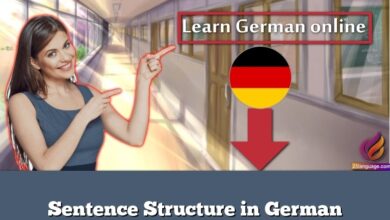Past continuous in German

Past continuous in German.Understanding the past continuous tense is not merely about knowing a grammatical rule; it’s a linguistic art that allows for the expression of temporal details and surrounding circumstances in a way that no other tense can offer.

Explanation about past continuous in German
- Context: One common way to indicate that an action was ongoing is through the use of adverbs or time expressions. For example, “Ich las das Buch den ganzen Abend” (I read the book the whole evening) implies that the action of reading was ongoing throughout the evening.
- Modal Verbs: Another way is to use modal verbs like “sein” (to be) in combination with “am” and an infinitive, although this is more common in spoken, colloquial German. For example, “Ich war am Lesen” could be used to express “I was reading.” This construction gives a sense of an ongoing activity but is less formal.
- Zusammengesetzte Zeiten (Compound Tenses): In some cases, you might find compound tenses used to indicate ongoing actions, but these are more common in written German or in a narrative context.
- Conjunctions and Phrases: Sometimes, Germans use conjunctions like “während” (while) to express ongoing actions. For example, “Während ich las, klingelte das Telefon” (While I was reading, the phone rang).
- Sein + dabei + Infinitive: Another colloquial expression to emphasize the ongoing nature of an action is to use “sein” (to be) along with “dabei” and an infinitive. For example, “Ich war dabei, das Buch zu lesen” (I was in the process of reading the book).
Examples for using past continuous in German
| English Example | German Equivalent | Explanation |
|---|---|---|
| I was reading | Ich las (den ganzen Abend) | Simple past with contextual information to imply ongoing action |
| Ich war am Lesen | Colloquial use of “sein” + “am” + infinitive to indicate ongoing action | |
| Ich war dabei, das Buch zu lesen | Using “sein” + “dabei” + infinitive for an ongoing action | |
| While I was reading | Während ich las | Using “während” (while) to indicate an ongoing action in the past |
| Als ich am Lesen war | Using “als” with the colloquial “sein” + “am” + infinitive | |
| I was eating | Ich aß (die ganze Zeit) | Simple past with contextual information to imply ongoing action |
| Ich war am Essen | Colloquial use of “sein” + “am” + infinitive to indicate ongoing action | |
| Ich war dabei, zu essen | Using “sein” + “dabei” + infinitive for an ongoing action | |
| While I was eating | Während ich aß | Using “während” (while) to indicate an ongoing action in the past |
| Als ich am Essen war | Using “als” with the colloquial “sein” + “am” + infinitive |
Sentenses for using past continuous in German
| English Sentence | German Sentence | Explanation |
|---|---|---|
| I was reading when he called. | Ich las, als er anrief. | Simple past with a time clause to imply ongoing action |
| Als er anrief, war ich am Lesen. | Colloquial use of “sein” + “am” + infinitive | |
| Ich war dabei, zu lesen, als er anrief. | Using “sein” + “dabei” + infinitive for ongoing action | |
| While she was cooking, the phone rang. | Während sie kochte, klingelte das Telefon. | Using “während” (while) to indicate an ongoing action in the past |
| Als das Telefon klingelte, war sie am Kochen. | Using “als” with the colloquial “sein” + “am” + infinitive | |
| He was studying all night. | Er lernte die ganze Nacht. | Simple past with contextual information (all night) to imply ongoing action |
| Er war die ganze Nacht am Lernen. | Colloquial use of “sein” + “am” + infinitive | |
| Er war dabei, die ganze Nacht zu lernen. | Using “sein” + “dabei” + infinitive for ongoing action | |
| They were watching TV. | Sie sahen fern. | Simple past to imply ongoing action |
| Sie waren am Fernsehen. | Colloquial use of “sein” + “am” + infinitive | |
| Sie waren dabei, fernzusehen. | Using “sein” + “dabei” + infinitive for ongoing action |
In conclusion, the past continuous tense remains one of the most nuanced and precise tools in the English language for depicting ongoing actions in the past. While understanding its grammatical structure is an essential first step, the true value of this tense lies in its practical application whether in daily conversations, academic writing, or storytelling.





























